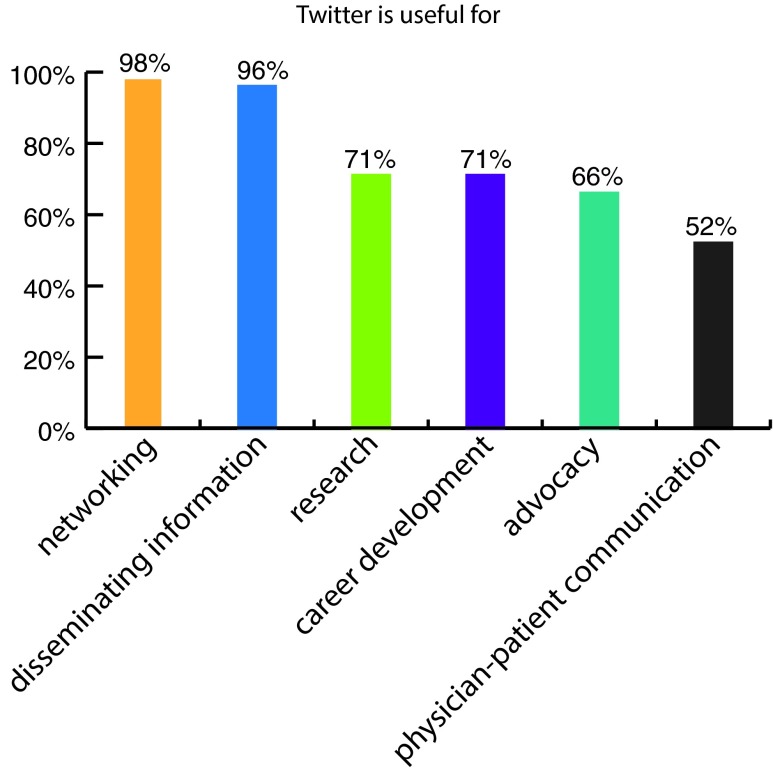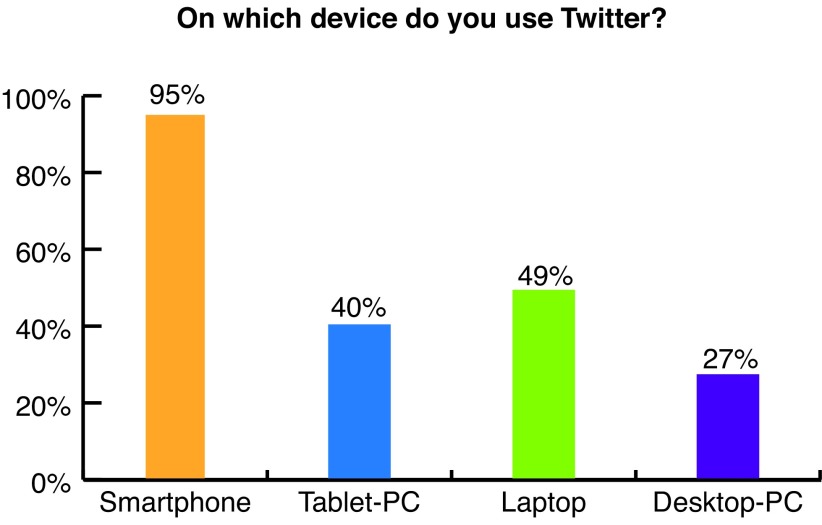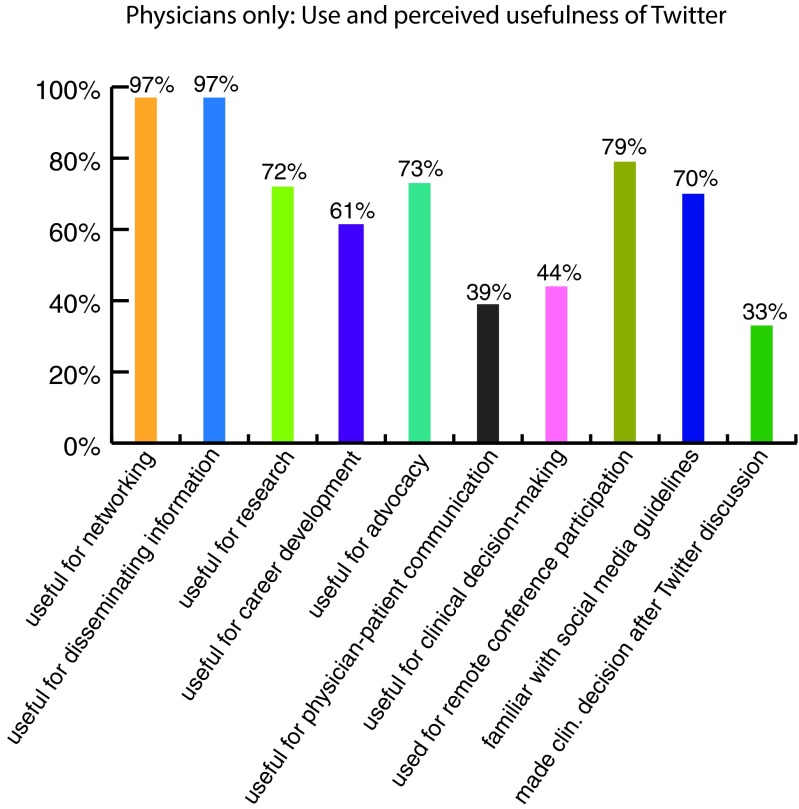Abstract
Introduction:
Twitter use has grown exponentially within the urological community. We aimed to determine the perceptions of the impact of Twitter on users’ clinical practice, research, and other professional activities.
Methods:
We performed an 11-item online survey of Twitter contributors during two major urological meetings: the European Association of Urology (EAU) and the American Urological Association (AUA) annual meetings. During the EAU 2014 meeting, we distributed the survey via the meeting official Twitter feed. During the AUA 2014 meeting, we applied a new method by directly sending the survey to Twitter contributors. We performed a subset analysis for assessing the perceived impact of Twitter on the clinical practice of physicians.
Results:
Among 312 total respondents, the greatest perceived benefits of Twitter among users were for networking (97%) and disseminating information (96%), followed by research (75%), advocacy (74%) and career development (62%). In total, 65% of Twitter users have dealt with guidelines on online medical professionalism and 71% of physician users found that Twitter had an impact on their clinical practice, and 33% had made a clinical decision based on an online case discussion.
Conclusions:
Our results suggest that Twitter users in the urological community perceive important benefits. These benefits extend to multiple professional domains, particularly networking, disseminating information, remote conference participation, research, and advocacy. This is the first study that has been disseminated to targeted individuals from the urological community directly through tweets, providing a proof of principle for this research method.
Introduction
Social media has increasing significance in the world of medicine and particularly in urology. According to surveys conducted by the American Urological Association (AUA), over two-thirds of members have a social media account,1,2 and Twitter use at urology conferences continues to expand.3–5 Twitter is a microblogging service involving short messages (or “tweets”) of ≤140 characters. Keywords (or “hashtags”) are used to index tweets together that are related to a particular topic, and are designated using the # symbol. At the European Association of Urology (EAU) congress, the number of conference-related tweets increased from 347 in 2012 to 5904 in 2014,3 and recently to 7110 in 2015.6
In addition to its growing use at conferences,3,4 Twitter is being used for a monthly international urology journal club, as reported by Thangasamy and colleagues, using the hashtag #urojc.7 During its first year, the club had 189 individuals from 19 countries discussing urological articles, demonstrating the capacity and feasibility of such an online club as an international platform for exchange of professional information. Additionally, an increasing number of urology journals are represented on Twitter, and there is a significant positive association between Twitter presence and impact factor.8
Despite the increasing use of social media in urology, its impact on users’ clinical practice, research activity, and career development remains unknown.9 A recent survey by the AUA demonstrated that a significant proportion of urologists remain unconvinced about the usefulness of social media, with a perceived lack of added value as a top reason for non-participation.2 The aim of our study was to assess the perceived utility of Twitter for professional goals and the perceived impact of Twitter on clinical practice of active Twitter physician users.
Methods
We designed an 11-item online survey using the platform www.surveymonkey.com on the perceived utility of Twitter for users’ clinical and academic practice (Appendix 1). The survey was designed and carried out in accordance with the Checklist for Reporting Results of Internet-E-Surveys (CHERRIES).10 It was not mandatory for participants to answer all survey questions.
The survey assessed the perceived utility of Twitter for the following professional activities: advocacy, networking, disseminating information, clinical decision-making, research, career advancement, and physician-patient communication. Participants were also asked about whether they had followed a congress remotely using Twitter, about their preferred social platforms and how they are accessed, and about their familiarity with professional social media guidelines.
Before administering the survey, we tested it for usability and technical functionality. During the pilot phase, the survey was disseminated in a non-targeted fashion on Twitter at the EAU Congress (April 11–15, 2014) using the conference hashtag #EAU14. It was tweeted out 8 times during various different days and hours of the congress from the individual Twitter account of one author (HB). To follow-up on the results, we used the Symplur website (www.symplur.com) to obtain a complete list of all 1199 participants in the 2014 AUA meeting Twitter feed (hashtag #aua14). We then initiated a larger phase of the survey by using Twitter to individually tweet the survey link to all 1199 #AUA14 Twitter contributors. This was accomplished by creating a new Twitter account (@urosurvey), through which we tweeted a description of the survey with its website address one time to each respective @username from the list of conference Twitter contributors. Since it is not possible to determine the specific job description of all Twitter profiles in the #EAU14 and #aua14 discussions, we asked participants their profession in the survey. We then performed a subset analysis of physicians to determine the impact of Twitter on the clinical practice in those who self-identified as physicians. This was addressed by three survey questions: (1) agreement with the statement “Twitter has an impact on my clinical practice” (responses on a 4-point Likert scale); (2) whether Twitter is useful for clinical decision-making (yes/no); and (3) whether the respondent has ever made a clinical decision based on an online case discussion (yes/no). Analytics were tallied using the tools within www.surveymonkey.com.
Results
A total of 312 unique individuals responded to the survey, including 57 during the pilot phase at the 2014 EAU meeting (representing 7.2% of all #eua14 Twitter users), and 255 of 1199 participants from the 2014 AUA Twitter feed (21.3% response rate) (Table 1).
Table 1.
Demographics of the survey participants
| Category | No. (%) |
|---|---|
| Profession | |
| Physician | 234 (75%) |
| Nurse | 10 (3%) |
| Researcher | 16 (5%) |
| Business person | 20 (6%) |
| Others | 32 (10%) |
| Status | |
| Trainee | 62 (20%) |
| Consultant | 188 (61%) |
| No answer | 60 (19%) |
| Age, years | |
| ≤20 | 1 (0%) |
| 20–29 | 40 (13%) |
| 30–39 | 127 (41%) |
| 40–49 | 94 (30%) |
| 50–59 | 40 (13%) |
| ≥60 | 10 (3%) |
| Continent of origin | |
| North America | 134 (43%) |
| Europe | 110 (35%) |
| Australia | 25 (8%) |
| South America | 20 (6%) |
| Asia | 13 (4%) |
| Africa | 9 (3%) |
The greatest perceived benefits of Twitter were for networking (97%) and disseminating information (96%) (Fig. 1). Most users also found Twitter beneficial for research (75%), advocacy (74%), and career development (62%). In addition to Twitter, the most commonly used social media platforms were Facebook (73%), LinkedIn (64%), and YouTube (50%); whereas Google+ (28%) and Pinterest (15%) were less common. (Fig. 2). Of the Twitter users, 76% of users indicated that they have followed a congress remotely and 65% indicated that they were familiar with guidelines for online professionalism.
Fig. 1.
Positive (“yes,” %) responses of 312 Twitter users from the European Association of Urology and American Urological Association 2014 meetings on the utility of Twitter for various professional activities.
Fig. 2.
Responses of 312 Twitter users from the European Association of Urology and American Urological Association 2014 meetings on the question on which device they use Twitter. Multiple answers were allowed.
The subset analysis included 234 physician participants. Among these, 14% strongly agreed and 57% agreed that Twitter has an impact on their clinical practice, while 23% disagreed and 5% strongly disagreed (Fig. 3).
Fig. 3.
Subset analysis containing 234 responses of physician Twitter users on their use and perceived usefulness of Twitter for clinical practice and other professional goals.
Discussion
Our results demonstrate for the first time that among this selected group of urology Twitter participants, virtually all find it useful for networking and disseminating information. Most respondents also found it useful for research, advocacy, and career advancement. In the subgroup of physician Twitter users, most perceived that Twitter also has an impact on their clinical practice. This phenomenon has not yet been reported and shows the great potential of Twitter, which has thus far only been shown as widely used for scientific communication at congresses.3
Among our selected group of Twitter users in 2014, the use of other social media platforms was higher than among randomly selected urologists in the United States in 2012 and in Canada in 2014.1,11 The higher social media uptake among our population can be explained by the bias of the survey population that already uses a social media platform and by the growing popularity of social media in recent years. In our analysis, Twitter was perceived useful for multiple professional goals, such as networking, disseminating research and advocacy. Of note, Twitter was rated as useful for networking by 97% of active Twitter users in our study, while in a previous study only 41% of Canadian urologists found social media useful for fostering new networking contacts for potential collaborations.11 Furthermore, social media (perhaps even all media) use is shifting from a classical desktop computer over laptop computers towards mobile devices. Almost all survey participants used Twitter on a mobile phone, while less than the half used it on laptop or desktop computers.
The scientific information flow through Twitter opens up the opportunity to follow a congress remotely. By either following the meeting stream in general, a particular topic hashtag, key opinion leaders in the field or all at once, the remote conference experience offers chances to filter the information needed from congress discussions. In our survey, 76% of Twitter users stated that they have already followed a congress remotely showing the great potential for remote conference participation.
Despite the many benefits of social media in urology, there are also potential dangers with regard to confidentiality and professionalism. Numerous organizations, including the EAU and AUA, and journals like BJU International, have created guidelines for physicians’ online behaviour.12–14 It is encouraging that most active users in our survey were familiar with these guidelines, which should be further disseminated as social media continues to expand in our field.
Although our survey included a limited number of queries and only a selection of engaged Twitter users in the #EAU14 and #AUA14 Twitter feeds, this study provides several important new insights. While surveys provide a low level of evidence and the study population may not represent the urological community at-large, nevertheless it is useful to understand the perceived benefits (or lack thereof) among active users. Yet it should be mentioned that these questions on utility were primarily captured in a binary fashion rather than on a Likert scale that gauges the level of enthusiasm.
Recently, social media platforms have successfully been used to improve clinical trial recruitment.15,16 Another contribution of our study is the use of Twitter as a novel social media tool to disseminate a survey by individually directed tweets at our target population. Each participant was sent a single tweet and we received only positive feedback, suggesting the feasibility of this approach. Indeed, the non-targeted survey distribution during the pilot phase led to fewer responses than the targeted survey distribution. This might be due to varying levels of engagement during conference hours17 and consequently a varying visibility of the tweet. We achieved a higher level of participation by directly tweeting the survey to target accounts with a description and the website address. Furthermore, our response rate of 21% using targeted tweets as a method of dissemination compares favourably with the 6.8% response rate in a previous AUA survey on social media sent via email.2 Thus, this study also demonstrates the feasibility of Twitter messages as a rapid and novel method to disseminate targeted surveys within the urological community.
Conclusion
Our survey suggests that most Twitter users at urology meetings do perceive numerous important benefits of social media use for networking, disseminating research, advocacy, clinical practice, and other professional goals. In addition, our study provides a proof of principle demonstration on the feasibility of using directed tweets to perform targeted survey research within the urological community.
Acknowledgments
We thank all Twitter users that participated in this survey.
Appendix 1. Survey-Twitter use of urologists
| 1. Twitter has an impact on my clinical practice | |||||
| strongly agree | agree | disagree | strongly disagree | ||
|
| |||||
| 2. Have you followed a congress remotely using Twitter? | |||||
| Yes | |||||
| No | |||||
|
| |||||
| 3. Which profession do you have? | |||||
| Doctor | |||||
| Nurse | |||||
| Researcher | |||||
| Business person | |||||
| Other | |||||
|
| |||||
| 4. Which status do you have? | |||||
| Trainee | |||||
| Consultant | |||||
| No answer | |||||
|
| |||||
| 5. Have you ever made a clinical decision based on an online case discussion? | |||||
| Yes | |||||
| No | |||||
|
| |||||
| 6. From which continent are you? | |||||
| Africa | |||||
| Asia | |||||
| Australia | |||||
| Europe | |||||
| North America | |||||
| South America | |||||
|
| |||||
| 7. Have you dealt with guidelines/recommendations on online medical professionalism? | |||||
| Yes | |||||
| No | |||||
|
| |||||
| 8. Twitter is useful for... | |||||
| Yes | No | ||||
| …advocacy | |||||
| …networking | |||||
| …disseminating information | |||||
| …clinical decision-making | |||||
| …research | |||||
| …career advancement | |||||
| …doctor-patient communication | |||||
|
| |||||
| 9. How old are you? | |||||
| Below 20 | |||||
| 20–29 | |||||
| 30–39 | |||||
| 40–49 | |||||
| 50–59 | |||||
| 60 or older | |||||
|
| |||||
| 10. Which social media do you use? | |||||
| Youtube | |||||
| Google+ | |||||
|
| |||||
| 11. On which device do you use Twitter? | |||||
| Smartphone | |||||
| Tablet-PC | |||||
| Laptop | |||||
| Desktop-PC | |||||
Footnotes
Competing interests: The authors all declare no competing financial or personal interests.
This paper has been peer-reviewed.
References
- 1.Loeb S, Bayne CE, Frey C, et al. Use of social media in urology: Data from the American Urological Association. BJU Int. 2014;113:993–8. doi: 10.1111/bju.12586. [DOI] [PubMed] [Google Scholar]
- 2.Loeb S, Bayne CE, Frey C, et al. On behalf of the American Urological Association Social Media Work Group Updated Survey of Social Media Use in the American Urological Association. Urology Practice. 2015. (In press). [DOI] [PubMed]
- 3.Wilkinson SE, Basto MY, Perovic G, et al. The social media revolution is changing the conference experience: Analytics and trends from eight international meetings. BJU Int. 2015;115:839–46. doi: 10.1111/bju.12910. [DOI] [PubMed] [Google Scholar]
- 4.Canvasser NE, Ramo C, Morgan TM, et al. The use of social media in endourology: An analysis of the 2013 world congress of endourology meeting. J Endourol. 2015;29:615–20. doi: 10.1089/end.2014.0329. [DOI] [PubMed] [Google Scholar]
- 5.Loeb S. Social media makes global urology meetings truly global. BJU Int. 2015;115:175. doi: 10.1111/bju.13027. [DOI] [PubMed] [Google Scholar]
- 6. Symplur.com Symplur: The Healthcare Hashtag project. http://www.symplur.com. Accessed May 20, 2015.
- 7.Thangasamy IA, Leveridge M, Davies BJ, et al. International urology journal club via Twitter: 12-month experience. Eur Urol. 2014;66:112–7. doi: 10.1016/j.eururo.2014.01.034. [DOI] [PubMed] [Google Scholar]
- 8.Nason GJ, O’Kelly F, Kelly ME, et al. The emerging use of Twitter by urological journals. BJU Int. 2015;115:486–90. doi: 10.1111/bju.12840. [DOI] [PubMed] [Google Scholar]
- 9.Loeb S, Catto J, Kutikov A. Social media offers unprecedented opportunities for vibrant exchange of professional ideas across continents. Eur Urol. 2014;66:118–9. doi: 10.1016/j.eururo.2014.02.048. [DOI] [PubMed] [Google Scholar]
- 10.Eysenbach G. Improving the quality of web surveys: The checklist for reporting results of internet e-surveys (CHERRIES) J Med Internet Res. 2004;6:e34. doi: 10.2196/jmir.6.3.e34. [DOI] [PMC free article] [PubMed] [Google Scholar]
- 11.Fuoco M, Leveridge MJ. Early adopters or laggards? Attitudes toward and use of social media among urologists. BJU Int. 2015;115:491–7. doi: 10.1111/bju.12855. [DOI] [PubMed] [Google Scholar]
- 12.Roupret M, Morgan TM, Bostrom PJ, et al. European Association of Urology (@Uroweb) recommendations on the appropriate use of social media. Eur Urol. 2014;66:628–32. doi: 10.1016/j.eururo.2014.06.046. [DOI] [PubMed] [Google Scholar]
- 13.American Urological Association: Social Media Best Practices http://www.auanet.org/press-media/social-media-bp.cfm. Accessed May 20, 2015.
- 14.Murphy DG, Loeb S, Basto MY, et al. Engaging responsibly with social media: The BJUI guidelines. BJU Int. 2014;114:9–11. doi: 10.1111/bju.12788. [DOI] [PubMed] [Google Scholar]
- 15.Shere M, Zhao XY, Koren G. The role of social media in recruiting for clinical trials in pregnancy. PloS one. 2014;9:e92744. doi: 10.1371/journal.pone.0092744. [DOI] [PMC free article] [PubMed] [Google Scholar]
- 16.Lane TS, Armin J, Gordon JS. Online recruitment methods for web-based and mobile health studies: A review of the literature. J Med Internet Res. 2015;17:e183. doi: 10.2196/jmir.4359. [DOI] [PMC free article] [PubMed] [Google Scholar]
- 17.Matta R, Doiron C, Leveridge MJ. The dramatic increase in social media in urology. J Urol. 2014;192:494–8. doi: 10.1016/j.juro.2014.02.043. [DOI] [PubMed] [Google Scholar]





